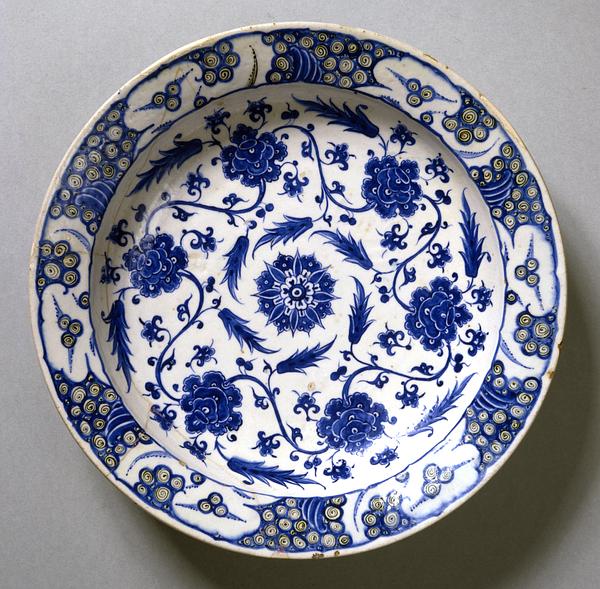Fritware dish, painted in blue and black under a transparent glaze
Turkey, Iznik; c. 1575
H: 7.3; Diam: 35.5 cm
Chinese porcelain was used in the sultans’ household. Much of it has been preserved in Istanbul in the Topkapi Palace complex’s museum, which holds one of the world’s finest collections of Chinese celadon and blue and white ware. This costly porcelain served as an ideal that the potters in Iznik also tried to copy very directly.
The decoration with fleshy peonies and leaves of different shapes was adopted from Chinese Ming-dynasty porcelain. This is also true of some of the decoration on the rim. The Turkish potter, however, highlighted its repeated wave motif with spirals in black, which is not found on Chinese blue and white ware.
Inv. no. 27/1978
Published in:
Yanni Petsopoulos (ed.): Tulips, arabesques and turbans: decorative arts from the Ottoman empire, London 1982, pl. 97, p. 94;
Nurhan Atasoy and Julian Raby: Iznik: the pottery of Ottoman Turkey, London 1989, fig. 447;
Esin Atil: The age of Sultan Süleyman the Magnificent, National Gallery of Art, Washington, D.C. 1987, cat.no. 171;
Kjeld von Folsach: Islamic art. The David Collection, Copenhagen 1990, cat.no. 181;
Kjeld von Folsach, Torben Lundbæk and Peder Mortensen (eds.): Sultan, Shah and Great Mughal: the history and culture of the Islamic world, The National Museum, Copenhagen 1996, cat.no. 388;
Kjeld von Folsach: Art from the World of Islam in The David Collection, Copenhagen 2001, cat.no. 261;
Walter B. Denny: Iznik: the artistry of Ottoman ceramics, London 2004, p. 169;
Walter B. Denny: Iznik : la céramique turque et l'art ottoman, Paris 2004, p. 169;
Asja Gimborg: Velikolepnyj vek osmanskogo iskusstva: dvorcy, meceti, garemy i nocnoj Bosfor, Moskva 2023, p. 124;
